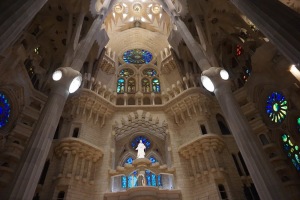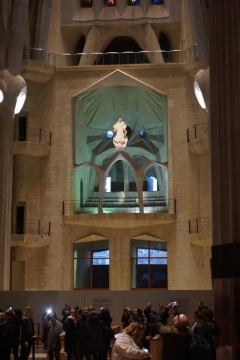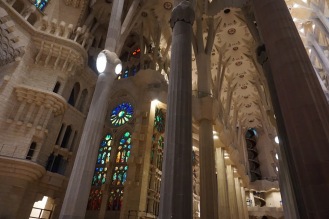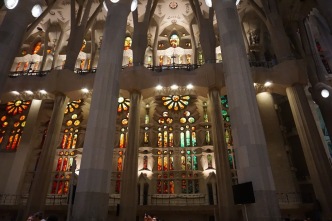Goodbye Barcelona
 As this semester is quickly coming to an end, I am experiencing a world wind of emotions. I cannot believe how fast this semester flew by. It feels like it was just yesterday my mom was dropping me off at LAX and we were saying our final goodbyes before I ventured off onto this journey. As I was boarding the plane to come here, I remember thinking to myself, “oh god what did I get myself into” and feeling as though I was not ready for the experience I was about to embark on. I had never even been to Europe before studying abroad, so I really had no clue what to expect. My experiences abroad have been characterized by the struggle of understanding the culture and the roller coaster of emotions.
As this semester is quickly coming to an end, I am experiencing a world wind of emotions. I cannot believe how fast this semester flew by. It feels like it was just yesterday my mom was dropping me off at LAX and we were saying our final goodbyes before I ventured off onto this journey. As I was boarding the plane to come here, I remember thinking to myself, “oh god what did I get myself into” and feeling as though I was not ready for the experience I was about to embark on. I had never even been to Europe before studying abroad, so I really had no clue what to expect. My experiences abroad have been characterized by the struggle of understanding the culture and the roller coaster of emotions.
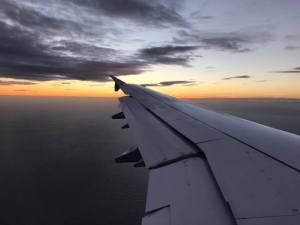 Before I got to Barcelona, I was aware that the culture and lifestyle here would be different from what I was used to in the United States. However, I think I was a little bit blindsided when I got here and saw just how different it really was. First and foremost, the biggest cultural difference for me was the amount of people I thought were being rude when I first got here. Within the first few days I had encountered multiple people that ran into me walking without saying sorry, got stared at an excessive amount, and didn’t see anyone smiling at one another ever. All these things were really shocking to me because none of which are normal to experience that often in the states. It took some time for me to realize that all these things are just apart of the culture here in Barcelona. It is not that the people here are impolite, it’s just that their culture is different from what I was used to. After being here for almost four months now, all these things seem totally normal to me and I wouldn’t consider them to be rude actions. At this point in my study abroad experience, I have fully adapted to the cultural norms of Barcelona.
Before I got to Barcelona, I was aware that the culture and lifestyle here would be different from what I was used to in the United States. However, I think I was a little bit blindsided when I got here and saw just how different it really was. First and foremost, the biggest cultural difference for me was the amount of people I thought were being rude when I first got here. Within the first few days I had encountered multiple people that ran into me walking without saying sorry, got stared at an excessive amount, and didn’t see anyone smiling at one another ever. All these things were really shocking to me because none of which are normal to experience that often in the states. It took some time for me to realize that all these things are just apart of the culture here in Barcelona. It is not that the people here are impolite, it’s just that their culture is different from what I was used to. After being here for almost four months now, all these things seem totally normal to me and I wouldn’t consider them to be rude actions. At this point in my study abroad experience, I have fully adapted to the cultural norms of Barcelona.


It’s safe to say I went through extreme highs and lows of emotions throughout the semester. As I learned in one of my courses at CEA this semester, it would be referred to as the “emotional roller coaster” that all abroad students typically go through. It starts arrival anticipation phase which happens before we got to Barcelona. This phase consisted of my extreme excitement to get here and dive right into whatever Barcelona had to offer. The next phase was denial and culture shock. As I talked about earlier I went through pretty severe culture shock when I first got here. I constantly found myself comparing everything to home back in the states and felt like everything people were doing here was “wrong”, rather than realizing it is just different. The third phase is the beloved honeymoon period. This consisted of me loving every single thing about being abroad. I felt like Barcelona was the greatest place in the world and that nothing could possibly affect me or make me not like it. Following the honeymoon period was the plunge phase. This is where I started having feelings of anxiety. I got very homesick during this time and just wanted to be with my family back in the states. Eventually I grew out of the plunge and went into the adjustment phase. This is when I begun to adapt the the cultural norms of Barcelona. Everything started to seem normal to me and I became very aware of my cultural surroundings. The final phase I have entered on the emotional roller coaster is the accommodation/assimilation phase. At this point I have fully embraced myself into Barcelona culture. I feel completely at home here and everything feels normal to me.
Overall, I am without a doubt, positive that I made the right decision to study abroad. More specifically, I am positive that I made the right choice when choosing Barcelona as my study abroad destination. A majority of my closest friends chose to study in Florence, which is where I thought I would end up as well. At the last minute, I changed my mind and chose to go a different route than them, which brought me to Barcelona. This was one of the first major things I have really done by myself and for myself, and I am so glad that I did. It taught me how to be more independent and do what is best for me. This semester was absolutely the best four months of my life. I learned that when people tell you studying abroad is a life changing experience, they aren’t lying. In fact, I would say that referring to it as a life changing experience is an understatement. I wouldn’t change the mistakes I made or the emotional roller coaster I went through here for anything. Barcelona officially has my heart and I will 100% be back here in the future.






 With the passing of Antoni Gaudi, the progression for the construction of the Sagrada Familia moved at a very slow pace. The only funding for the project at the time was through private donors which played a factor into why construction was moving so slowly. The construction was also delayed due to the
With the passing of Antoni Gaudi, the progression for the construction of the Sagrada Familia moved at a very slow pace. The only funding for the project at the time was through private donors which played a factor into why construction was moving so slowly. The construction was also delayed due to the  The cost of entry to visit the Sagrada Familia is a bit pricey ranging from 15-29 euros. The prices ranges depending on the amount of access within the church you have. The lower level tickets don’t allow you access to the towers. However, these hefty entrance fee’s do not stop the tourists from visiting. These fee’s finance the annual budget of 25 million euros for construction. This means that roughly 1.5 million people visit the Sagrada Familia per year.
The cost of entry to visit the Sagrada Familia is a bit pricey ranging from 15-29 euros. The prices ranges depending on the amount of access within the church you have. The lower level tickets don’t allow you access to the towers. However, these hefty entrance fee’s do not stop the tourists from visiting. These fee’s finance the annual budget of 25 million euros for construction. This means that roughly 1.5 million people visit the Sagrada Familia per year.  With all the effort that has gone into the construction of the Sagrada Familia, the board members take all potential threats very seriously. In March of 2010, the construction of the
With all the effort that has gone into the construction of the Sagrada Familia, the board members take all potential threats very seriously. In March of 2010, the construction of the 
 The interior design of the Sagrada Familia is just as intricate as it is on the outside. None of the pieces on the inside are flat and all consist of abstract shapes. Much of the inside decor is pointy and sharp. When designing the Sagrada Familia Gaudi’s intentions were to use his
The interior design of the Sagrada Familia is just as intricate as it is on the outside. None of the pieces on the inside are flat and all consist of abstract shapes. Much of the inside decor is pointy and sharp. When designing the Sagrada Familia Gaudi’s intentions were to use his 